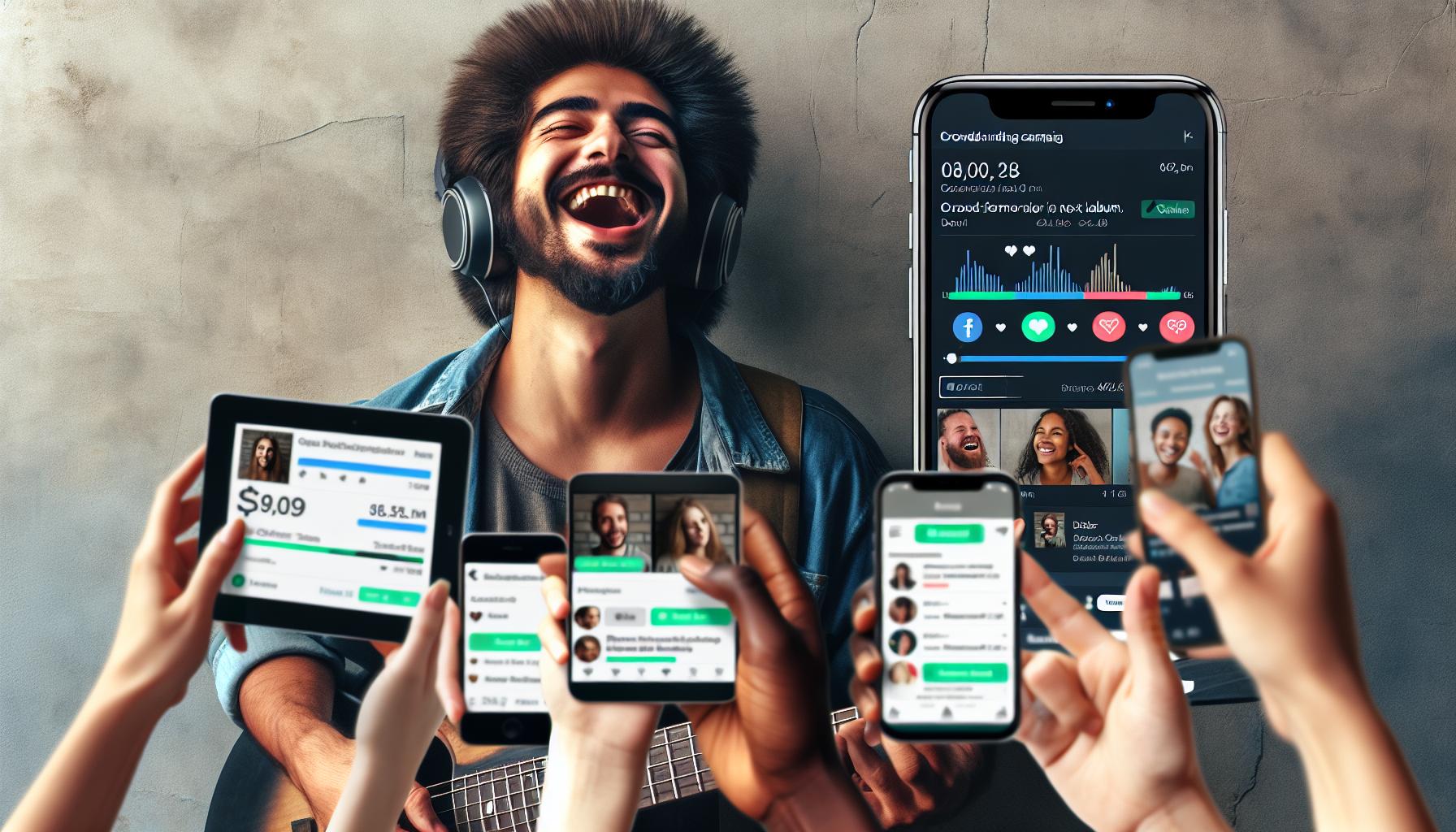Creating music isn’t just about talent. It’s also about resources. And let’s face it, not everyone’s got a record label backing them up. That’s where music crowdfunding comes in. It’s a game-changer for indie artists and bands looking to fund their music projects.
Crowdfunding platforms like Kickstarter and Indiegogo have become the go-to solution for artists worldwide. They’re not just raising funds, they’re building a community of loyal fans who believe in their music.
In this article, I’ll take you through the ins and outs of music crowdfunding. From setting up your campaign to promoting it, I’ve got you covered. So, if you’re ready to take your music to the next level, keep reading.
Contents
What is Music Crowdfunding?
Music Crowdfunding is a new wave in the industry that’s changed the game for independent music creators globally. If I look back a decade ago, securing resources for music creation involved serious hurdles. It either meant digging deep into own pocket or convincing labels and sponsors who potentially gained control over the creative process.
But not anymore! Thanks to crowdfunding platforms that let music creators retain their independence while raising funds. Characterized by its community-based approach, it’s a system where fans and supporters invest money towards the future projects of their favorite artists. With each backer essentially becoming a mini-patron, artists receive the funding they need to bring their projects to reality, all while maintaining creative control.
Platforms like Kickstarter and Indiegogo are thriving examples of this phenomenon. Statistics reveal that Kickstarter alone has successfully funded over 200,000 projects, with a total turnover crossing $5 billion since its inception. Below is a brief overview:
| Platform | No. of Projects Funded | Total Turnover |
|---|---|---|
| Kickstarter | Over 200,000 | Over $5 billion |
| Indiegogo | Not Public | Not Public |
You might think the process is as simple as creating a campaign and waiting for funds to roll in. Contrarily, running a successful crowdfunding campaign involves careful planning and strategic marketing to persuade people to invest in your vision.
It’s important to note that there are two key types of crowdfunding: rewards-based and equity-based. In rewards-based crowdfunding, backers receive perks or exclusive material in return for their support, whereas, in equity-based crowdfunding, backers receive a share in the future profits of the project.
In the next section, I’ll guide you on how to effectively set up and promote a crowdfunding campaign for your music project, ensuring you have all the tools you need to win your audience over. Stay tuned.
Benefits of Music Crowdfunding

Stepping into the world of music crowdfunding can crack open an array of promising benefits. Crowdfunding platforms aren’t just a financial lifebelt for independent artists. They are also a springboard for new opportunities, turning creative dreams into reality.
First off, let’s get one thing straight: crowdfunding isn’t just about the money. Of course, financial support is a huge part of it – no one’s denying that. But it’s important to prove that crowdfunding is much more than just a way to cover costs.
Crowdfunding amplifies your network. By running a crowdfunding campaign, you’re effectively stepping into the spotlight. You attract like-minded individuals who not only back your project with their hard-earned cash but also become devoted fans and vocal advocates. They’ll help spread your music, your story, and your brand far beyond your existing circles.
Next up: crowdfunding grants you creative control. Signing with a record label often means giving up a portion of your creative freedom. They have specific demands, certain expectations, and a lot of bills to pay. Crowdfunding, on the other hand, lets you call the shots. You produce the music you want to produce, you decide when it’s ready to be released, and you keep every cent of the proceeds.
Don’t forget: crowdfunding can validate your idea. In the cutthroat world of music, it’s hard to predict whether people will resonate with your work. A successful crowdfunding campaign is often a clear indication that there is a market, a demand for what you are offering.
Keep reading to the subsequent sections where I’ll be explaining how you can make the most of the benefits associated with music crowdfunding and run a successful campaign.
Choosing the Right Crowdfunding Platform

Starting a crowdfunding campaign is not a small task. One of the first, and most vital, steps of this journey involves selecting the right crowdfunding platform. It’s not about just picking the most popular one, but identifying a platform that fits the unique needs of your music project.
There are countless crowdfunding platforms out there, each with their own pros and cons. I’ll highlight a few notable ones.
- Kickstarter: Known for hosting a variety of creative projects including music. Kickstarter supports fixed funding which means you only get the funds if the project meets its goal.
- Indiegogo: An international platform supporting both fixed and flexible funding. Flexible means you get to keep whatever you’ve raised, even if you don’t meet your goal.
- Patreon: This is a subscription-based site that allows your supporters to pay a certain amount per creation or per month, providing consistent support for your musical pursuits.
When deciding, remember to compare fees. Each platform takes a different percentage of the funded money as its operating fee.
For example, Kickstarter charges 5% of the total funds raised and an additional 3% + $0.20 per pledge, while Indiegogo charges 5% of the funds raised and a 3% processing fee.
However, fees should not be your only consideration. Other factors should include the platform’s traffic, success rate, usability, and whether it appeals to your target audience. Without a strong user base interested in music, your chances of reaching your funding goal may be slim.
Coupling your musical project with the right crowdfunding platform strengthens your campaign’s success rate. Making an informed decision by considering all these parameters will pay off in the long run.
Tapping into the power of crowdfunding isn’t just about fundraising. It’s about creating a community of supporters who appreciate your art and want to see you succeed. With the hard work of research and preparation upfront, the potential to run a successful campaign is greatly increased.
| Platform | Fee of total funds raised | Processing Fee |
|---|---|---|
| Kickstarter | 5% | 3% + $0.20 /pledge |
| Indiegogo | 5% | 3% |
| Patreon | 5-12% | 2. |
Setting Up Your Music Crowdfunding Campaign

After pinpointing the perfect platform, it’s time to set the stage for your music crowdfunding campaign. Constructing a compelling campaign requires careful thought, meticulous planning, and a lot of heart. It’s so much more than just requesting financial support. It’s about telling your story, sparking curiosity, and encouraging supporters to come along on your creative journey.
Preparing a compelling campaign pitch is the first order of business. In it, you’ll need to detail what you’re planning to create, how much you need to bring it to life, and what your supporters will get in return for their pledges. Remember to be realistic with your financial goal; It’s best to set the bar at the sum you honestly need to see your project through. Setting your sights too high may deter potential backers, while setting it too low may leave you underfunded.
To help illustrate the point, here’s a quick rundown of the typical campaign element breakdown:
| Campaign Element | Description |
|---|---|
| Project Title | This should be catchy, clear, and related to your project. |
| Funding Goal | The amount you genuinely need to complete your project. |
| Project Description | A detailed depiction of the project and its importance. |
| Pledge Rewards | Creative ways to show your appreciation to backers. |
High-quality visuals can keep potential backers engaged. Thoughtful images and videos can amplify your message and provide a behind-the-scenes look at your creative process. Make sure any and all multimedia align with the overall theme and aesthetic of your project.
Beyond the campaign pitch, cultivate a community by providing regular updates about your project. This helps to build trust with backers and later makes them your loyal supporters. Investing time in communicating effectively with your supporters can go a long way in ensnaring their interest towards your campaign.
Here’s a tip: Invite your followers to private listening sessions, offer signed merchandise, or provide updates on the creative process to keep them engaged. Give them a reason to stick around, interact, and invest. After all, your backers aren’t just funders – they’re part of your project’s unique narrative.
Creating an Engaging Pitch Video
Arguably, one of the most cracking aspects of any music crowdfunding campaign is the pitch. A stellar pitch video can truly make or break your campaign. Unique, compelling, and highly engaging, the right pitch can help you connect on a deep emotional level with your potential backers.
Let’s break down what makes a pitch video truly stand out:
1. Tell Your Story
In every pitch video, it’s essential to share not just what you’re doing, but why. People need to feel invested in your project and your story. Are you a young musician trying to record your first album? Or maybe you’re a seasoned veteran planning a worldwide tour. Whatever your story, make sure it’s at the heart of your video.
2. Showcase Your Talent
Don’t just talk about your music. Show it. Include snippets of you playing, recording, or performing. This is a tangible way for potential backers to see what they’re investing in.
3. Be Authentic
People can tell when a performance is forced. So, be you. This isn’t an audition tape; it’s a window into your world as a musician. Authenticity breeds trust – a crucial factor for potential backers.
4. Clarify Your Vision
Don’t forget to clarify what you aim to achieve with the crowdfunding. Detail your goals, your dreams and how the funding will support those.
Creating an engaging and creative video might seem daunting but it’s worth the effort. The perfect pitch video can rally more support for your cause, reach a broader audience, and ultimately, help make your music dreams come true.
When it comes to creating a pitch video, think outside the box, let your uniqueness shine through and let the music do the talking. But remember, no pitch, no matter how polished, can quit make up for lack of engagement with potential backers or a community that feels neglected. So as we look at pitching, make sure that communication and engagement remain key priorities throughout your campaign.
Offering Attractive Rewards to Supporters
When it comes to crowdfunding for a music project, offering enticing rewards is a powerful motivation for potential supporters. It’s not only about raising funds. It’s also about building relationships and providing value to those who believe in your talent.
Customized rewards give backers a unique experience and boost their desire to contribute. They’d rather give you $50 for an exclusive signed poster than just donate. People want to feel part of your journey.
First, we need to identify what your followers would love. Do they crave exclusive access, early bird specials or unique merchandise? It’s crucial to put yourself in your supporters’ shoes and imagine what you would like if you were them.
Once you have your list of attractive rewards, categorize them into different pledge levels and make sure it’s scalable and feasible. Here’s a simple markdown table to showcase an example:
| Pledge Level | Reward |
|---|---|
| $10 | Digital download of the album |
| $30 | Signed CD and digital download |
| $50 | Exclusive T-Shirt, CD, and download |
| $100 | Live video chat, T-Shirt, CD, and download |
Keep in mind, however, that while tangible rewards are great, experiential rewards might have a more significant impact. This could include experiences like a private online concert, a chance to meet you virtually, or even include their name in your album notes.
Also, remember that shipping costs can quickly add up. Try to balance digital and physical rewards to control costs and ensure weight and size won’t be a problem. Offering digital rewards also ensures international fans can participate without worrying about delivery.
Always ensure you deliver what you promise – it’s central to maintaining trust with your backers. Failure to deliver prizes can lead to disappointed backers and a tarnished reputation. It’s therefore essential to be realistic in what you can deliver and to set clear expectations from the start.
This doesn’t just stop once your project is funded. Continual engagement and updates about how their rewards are being fulfilled allow your backers to be part of your journey even after the campaign is long over.
As we delve deeper into the elements of a successful crowdfunding campaign, we’ll also take a look at the importance of post-campaign activities.
Promoting Your Music Crowdfunding Campaign

Launching a music crowdfunding campaign isn’t quite enough; I’m here to tell you, it’s crucial that you actively promote it as well. Now you might be wondering why that’s important. Visibility is key in crowdfunding. Without proper exposure, potential supporters may never see your music project, leave alone pledge their support.
Start by tapping into your personal network. Reach out to family, friends and acquaintances. There’s a high chance these people already believe in you and your talent. Consequently, they’re likely ready to pledge their support and also help spread the word.
Social media is your next best bet. Platforms such as Facebook, Twitter, and Instagram offer a wide audience base. Share your crowdfunding campaign on these platforms. Tailor your posts to cater to each platform’s audience. You’re more likely to attract more potential supporters.
The true power of social media, however, lies in its ability to propel content into the viral hemisphere. Encourage your followers to share your posts. The more shares you get, the further your music project reaches.
Simultaneously, reach out to popular blogs and websites in the music industry. These platforms often feature up-and-coming artists and could provide additional exposure for your music project.
Pitch your music project in a compelling way. Try to hook potential supporters with a captivating story. Sell them on why your project deserves their support. While you’re at it, don’t forget to mention the attractive rewards they stand to gain for their support.
Lastly, reckon with the power of email campaigns. Emails allow you to directly drop into your potential supporters’ inbox. You can use this platform to reach out to individuals who’ve shown interest in your music before.
Remember, the success of your music crowdfunding campaign largely depends on how well you manage to promote it. Use all these strategies to spread the word, attract attention, and drive potential backers to your campaign page.
Managing and Fulfilling Backer Rewards

After highlighting the major steps towards a successful crowdfunding campaign, it’s now time to discuss an equally important aspect – dealing with backer rewards.
Delivering on your promise is critical to establishing credibility and trust among your supporters. Swiftly fulfilling backer rewards not only validates their support but could also make them lifelong fans who continue to support your future music projects.
It starts with planning your rewards structure wisely. In my experience, it’s best to keep it simple. Too many options can create confusion and too few may not be attractive enough. With rewards, always ensure they’re easily deliverable and won’t put you in a tough financial position post-campaign.
Shipping costs can be a real pain when dealing with physical rewards like CDs, merchandise, or exclusive event tickets. Factor these costs into your budget to avoid unexpected blows to your finances.
Understand that some backers may be content with just digital rewards. Offering exclusive digital content like early access to your music, personalized messages, videos, or behind-the-scenes experiences can be fulfilling and cost-effective.
If you’re dealing with large numbers of backers, consider using a pledge manager to help streamline the process. These tools, like BackerKit or CrowdOx, simplify the logistics of reward delivery, ensuring that every backer gets what they’ve pledged for.
Consider this table to understand the role of a pledge manager:
| Role | Benefit |
|---|---|
| Helps organize backers’ information and their rewards | Keeps everything in one place and reduces chances of miscommunication |
| Helps in choosing additional add-ons | Enhances backers’ experience and increases potential funding |
Just remember, the main goal here is to keep your backers happy and loyal. So every step you take in managing and fulfilling your backer rewards should aim to achieve this.
Going forward, we will take a deep dive into the world of PR and how it plays a vital role in your crowdfunding journey.
Case Studies of Successful Music Crowdfunding Campaigns

Let’s dive into some real-life success stories that highlight the power of crowdfunding for music projects. These campaigns have not only achieved their financial goals, they’ve also cultivated a supportive community around their projects.
Firstly, we have Amanda Palmer, an independent artist who turned to Kickstarter for her album, Theater is Evil. Launching the campaign with an initial goal of $100,000, Palmer astounded everyone by raising over 1.2 million dollars. Thanks to a robust rewards system that ranged from digital downloads to art books and even private performances, she was able to capture the interest of a broad audience.
Another noteworthy success is Neil Young’s high-resolution music player, PonoMusic. Young pitched his offering on Kickstarter, aiming to raise $800,000. He far exceeded his goal, ending up with more than $6 million in pledges. Offering branded merchandise along with the product itself, Young connected with fans on a personal level and successfully launched his product into the market.
| Artist | Project | Platform | Goal | Raised |
|---|---|---|---|---|
| Amanda Palmer | Theater is Evil | Kickstarter | $100,000 | $1,200,000 |
| Neil Young | PonoMusic | Kickstarter | $800,000 | $6,000,000 |
In the process of examining these successes, we can extract key strategies for running a thriving campaign. Offering varied rewards that cater to different levels of investment will attract a wider audience. Connecting on a personal level with supporters, through updates or exclusive content, can build a committed community around your work. Remember, crowdfunding isn’t just about funds – it’s about fostering relationships with those who believe in your artistic vision.
As part of this journey into the world of music crowdfunding, we will now delve into the role of PR in running successful campaigns. Isn’t it provocative to think about how public relations can make or break your crowdfunding success?
Conclusion
So, we’ve seen the impact crowdfunding can have on music projects. It’s not just about getting the funds, it’s also about building a community of supporters. By offering compelling rewards, you can attract backers and make them feel part of your journey. Promoting your campaign actively is key to reaching your goal. We’ve looked at Amanda Palmer’s album and Neil Young’s music player as shining examples of what can be achieved. Crowdfunding is indeed a powerful tool for musicians, and it’s all about the connection with supporters. In our next discussion, we’ll delve into the crucial role PR plays in crowdfunding. Stay tuned!
